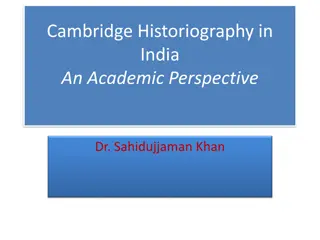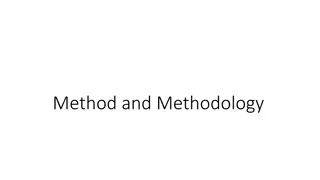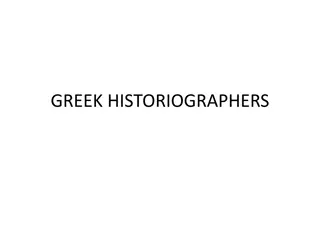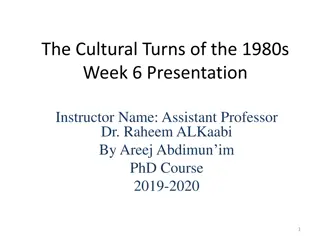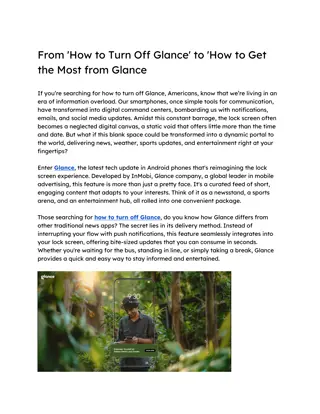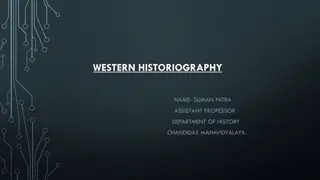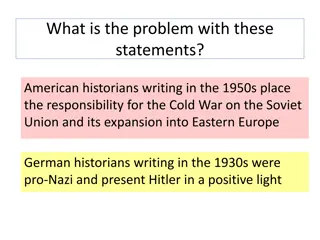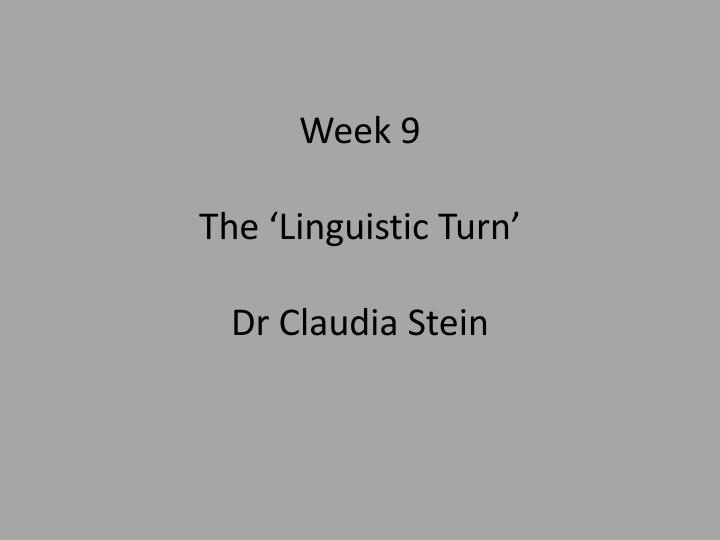
The Linguistic Turn: Philosophy, Language, and Human Experience
Explore the origins and impact of the Linguistic Turn, a philosophical movement focused on the relationship between language, human experience, and understanding the world. From its roots in philosophy to its influence on history writing, this turn challenges traditional paradigms and redefines how we perceive and express our experiences through language. Delve into the central issues of human experience and language's role in shaping our understanding of the past and present, all within the context of postmodernity and postmodernism.
Download Presentation

Please find below an Image/Link to download the presentation.
The content on the website is provided AS IS for your information and personal use only. It may not be sold, licensed, or shared on other websites without obtaining consent from the author. If you encounter any issues during the download, it is possible that the publisher has removed the file from their server.
You are allowed to download the files provided on this website for personal or commercial use, subject to the condition that they are used lawfully. All files are the property of their respective owners.
The content on the website is provided AS IS for your information and personal use only. It may not be sold, licensed, or shared on other websites without obtaining consent from the author.
E N D
Presentation Transcript
Week 9 The Linguistic Turn Dr Claudia Stein
Linguistic Turn The term was first used by the American philosopher Richard Rorty in an edited volume, entitled The Linguistic Turn (1967). At its core stands a new focus on the relationship between language, language users, and the world perceived through human experience and expressed through language. This linguistic turn begins in philosophy and literature studies/criticism and then spreads to the humanities as a whole. The linguistic turn in history writing It has become a catch-all phrase for divergent critiques of established historical paradigms, narratives and chronologies, encompassing not only poststructuralist linguistic criticism, linguistic theory, and philosophy but also cultural and symbolic anthropology new historicism and gender history. (Kathleen Canning, Feminist history after the Linguistic turn: Discourse and experience, Sign, 19,2 (1994), p. 147.
Central issue: What is human experience? Is human experience prior to the use of language? Central issue in Anglo-American history writing from the late 1980s/early 90s: The seemingly simple recognition that the category of experience (out of which historians such as E.P. Thompson argue comes class consciousness) is in fact not prior to and constitutive of language but it is actively constituted by language, has been increasingly been recognized as having far-reaching implications. (Patrick Joyce, Visions of the People: Industrial England and the Question of Class, 1884-1914),p. 9. Claim: language constitutesALL human experiences. Language makes our experience that includes what we now call our lived experience ! There is nothing authentic about your very own experience. Ergo, human experience is not universal or transhistorical (as new social historians claimed). As humans use language to express their experience , experience is not suitable to link the past and the present. Our experience is not shared by those in the past. It is constituted in entirely different ways. What stands behind this view?
Lecture outline Two central theories that constitute the linguistic turn : 1. French views: structuralism and poststructuralism: Roland Barthes 2. American views: history is literature: Hayden White
The linguistic turn as an intellectual response to the conditions of postmodernity Def. Postmodernity: This term refers to a set of perceived (sociological, cultural, political, economic, technologicaletc.) conditions of everyday life, which are perceived as distinctly different from the conditions of modernity . The discussion of postmodernity is the discussion of these conditions. The debates intensify during the 1960s and they coincides with the rise of post-industrial societies in the West, which was marked by a transition from a manufacturing-based economy to a service-based economy. Def. Postmodernism: Postmodernism is the intellectual response to the conditions of postmodernity. The linguistic turn is one of these many responses. By questioning human experience, it also questions all human knowledge production (scientific, economic, political, sociological, historical, anthropological and so on) which is based on language.
So, once again, what is at stake in postmodernism and the linguistic turn? The question of how to understand human experience. Central claim: Can humans represent the reality of human experience when they have to use language to express and communicate these experiences? Note: history writing from the 1960s claims to resurrect the experience of the forgotten people of the past or to make-meaning of past experiences (anthropological turn)
The linguistic turn as an expression of a postwar intellectual crisis in all disciplines of the human and social science The linguistic turn is an expression of a fundamental breakdown of European intellectual traditions going back to the Enlightenment. All disciplines in the human and social sciences, including history writing, find themselves in crisis mode. Why: The intellectual and moral basis of their modern existence the Enlightenment seems to be bankrupt! Enlightenment, understood in the widest sense as the advance of thought, has always aimed at liberating human beings from fear and installing them as masters. Yet the wholly enlightened earth is radiant with triumphant calamity. (Theodor W. Adorno and Max Horkheimer, Dialectic of the Enlightenment, 1947) Enlightenment is totalitarianism (Theodor W. Adorno/Max Horkheimer, Dialectic of the Enlightenment, 1947) Claim: The celebration of reason by thinkers of the 18th-century Enlightenment had led to the development of technologically sophisticated but oppressive and inhumane modes of governance, exemplified in the 20th century by fascism and totalitarianism.
The Enlightenment produced myths --it is a grand narrative (or meta-narrative) The linguistic turn is one of the many attempts undertaken in postwar human and social sciences in Europe and America to question the Enlightenment ideals and reveal them as mythical . The task becomes to lay bare the hidden the grande narrative (or (meta-narrative) of the Enlightenment
Part I: Linguistic Turn France Vichy regime, 1941-1944; collaboration with the occupier Nazi-Germany Postwar conservative governments; communism widespread, especially among intellectuals Decolonisation (e.g. Algerian War of Independence 1954-1962) Economic crisis of the 1970s Civic rights movements, feminism, student revolts,
Intellectual responses: take up late 19th and early 20th critiques of modernism Focus on language Ludwig Wittgenstein (1889-1951) Friedrich Nietzsche (1844-1900)
Another hero whose work is rediscovered in the 1950s Cours de linguistique g n rale (1916) Linguistics: scientific study of language in broadly three aspects: language form, language meaning, and language in context Ferdinand de Saussure, 1857-1913
Saussure replaces the term word with signs... Image:Tree.gif Sign, signifier, signified: The sign is constituted by the relationship of a signifier (a medium, such as a word, a road sign, a gesture etc) to a signified (also known as the referent, the thing being signed.) Note: The signified is not the thing itself, only a mental concept of it which the speaker and listener share.
Saussures central structuralist claims: 1. Languages are not confined to words but include any system of communication that uses signs . A sign is composed of a signifier (vocal sound, image, gesture) and a signified (the mental concept that speaker and listener share). 2. The mental concept/structure precedes the signifier in existence (according to Saussure, and that is what structuralists follow (and what later poststructuralists reject) 3. A signifier is established quite and bears no resemblance to the signified . (different language use different signifiers for the same mental images) 4. 5. Every sign acquires meaning only by belonging to a network of other signs. There is in every sign a suggestion of another, oppositional sign (binary relations: women/man; child/adult; animal/human etc.)
Significance of these claims: Relationship to knowledge becomes uncertain by undermining the connection between a word (signifier) and a thing (signified) with no relation to the real thing. Meaning and sign are separated. The notion of arbitrariness of the sign deeply challenged the correspondence theory of truth: if words relate only to each other within an own structure, how could language be deemed to refer to the world out there? And how would historians argue that their discourse about the past matched up with what really happened as Ranke, for example, had famously argued? During the linguistic turn Saussure s ideas were applied to wider human culture; central claims became : Reality is not representable in any form of human culture (whether written, spoken, visual or dramatic) No authoritative account can exists of anything. Nobody can know everything, and there is never one authority on a given subject. There is no authority!
How are these ideas applied and re-worked in Roland Barthes work Barthes develop Saussure s theory further and politicises it by moving it from the narrow study of language to the study of cultural and every-day objects. note:for Saussure signs were not political but neutral as he was only talking about their meaning within language and not in culture at large) Unlike Saussure, Barthes was politically on the left (in an ultra conservative France of the 1950s). Roland Barthes, 1915-1980, literary theorist, essayist, philosopher and semiotician He observed that all sign systems are highly motivated and deeply structured by political power. Understanding each sign, he argued, meant placing it in its political context
Signs in Everyday Culture Mythologies, 1957: essay collection, using structural linguistic analysis of cultural icons such as Soap-Power and Detergent or in Novels and Children (an acid attack on the women s magazine Elle); Steak and Chips ; Striptease (the commodification of female nakedness and sex industry); Plastic ; The New Citroen ; The Brain of Einstein , Wrestler ) Aims to expose how bourgois French society 1950/60 asserted its values
Barthes as a Structuralist The goal of all structuralist activities is to reconstruct an object in such a way as to make evident the rules of its functioning . Reminder Structuralism: Barthes does not invent structuralism which posits that elements of human individual and collective identities in society/culture must be understood in terms of their relationship to a larger, underlying invisible -- system or structure (e.g. the anthropologist Clifford Geertz and his method of thick description in, Interpretation of Culture(1973) is structuralist. Karl Marx s theories were structuralist, too. So, is Saussure. The starting point of these reflections was usually a feeling of impatience at the sights of the naturalness with which newspaper, art and common sense constantly dress up a reality which, even though it is the one we live in, is undoubtedly determined by history. In short, in the account given of our contemporary circumstances, I resented seeing Nature and History confused at every turn, and I wanted to track down the decorative display of what-goes-without-saying, the ideological abuse which, in my view, is hidden there. (Barthes, Mythologies, p. 11)
The study of hidden meanings -- semiology Barthes argued that an oppressive ideology was normalised in society by silent sign systems in everyday popular culture that goes beyond Saussure s original ideas of the signifier-signified. Barthes calls this larger system myth . Everybody in a culture understands nor just the sign but also the myth to which it belongs. Barthes showed that signs and sign systems were embedded codes with normative meanings. Barthes called all of this 'the semiological system', and the study of the hidden meanings he called 'semiology'.
Exercises in semiology for the seminar: what is the hidden myth in these images?
Barthes Poststructural Phase Death of the Author (1967) Main claim: the meaning of a text is not determined by the author's intention (or some other sort of structure) but rather by the reader s own interpretation Def. Poststructuralism: a philosophical direction within the wider movement of postmodernism. Postmodernists argue that all knowledge is constructed by humans (and language) within a given culture and time. They admit that no facts exist independent of structure . But they tend to not understand these structures as real or fixed . They are interventions of the observer/reader and they are historical (e.g. class or experience ) Poststructuralists tend to argue that while we need to be aware of structures ``(using them as devices for to aid our inquiry), we need to de-centre them and problematise them for study (e.g. Joan Scott s famous article on experience is a perfect example of this approach).
Central question of poststructuralists: What is a text? A text is the material manifestation of a multiplicity of signs, discourse and structures. Deconstruction: a form of criticism which asserts that there is not one single intrinsic meaning to be found in a work, but rather many, and often these can be conflicting. A deconstructive approach to criticism involves discovering, recognising and understanding the underlying and unspoken and implicit assumptions, ideas and frameworks of cultural forms such as literary or historical texts. Jacques Derrida, 1930-2004 Grammatology (1976): Language is made made by exclusion of the real; nature disappears from the text The Postmodern Condition, 1977: Postmodern manifesto, arguing for the end of the Enlightenment project; coins the term the postmodern condition Il n y a pas de hors-text ( there Is no nothing outside text ) Jean-Fran ois Lyotard (1924-1998)
Is history truly nothing but a text in need to be endlessly deconstructed ?
Part 2: American Literary Criticism and the Linguistic Turn Is history writing simply literature? Metahistory: The Historical Imagination in Nineteenth-Century Europe (1973). My own analysis of the deep structure of the historical imagination of nineteenth century Europe is intended to provide a new perspective on the current debate over the nature and function of historical knowledge. (Metahistory, p. 2). Hayden White, 1928-2018 White contradicts the view that "historiography can be objective or truly scientific in itself, unaffected by anything." Note: His work reflects the widespread Anglo-American misunderstanding of Ranke s critical method (i.e. empirical, objective).
Metahistory considers eight major figures of 19th -century history writing among them Leopold von Ranke. The histories of these men, White argues, are characterized by four modes of linguistic prefiguration (Metaphor, Metonymy, Synecdoche, and Irony), four theories of truth (Formism, Mechanism, Organicism, Contextualism), four archetypal plot structures (Romance, Tragedy, Comedy, Satire), and finally four ideologies (Anarchism, Radicalism, Conservatism, and Liberalism). Main point: to deconstruct a mythology, the so-called positivistic science of history. History is not neutral, rather it entails entails ontological and epistemic choices with distinct ideological and even specifically political implications. Narrative is thus inextricably bound to issues of authority. In sum: Metahistory tossed the entire concept of historical science out the window, claiming that historians are fundamentally artists who imbue historical action empirically collected in the archives -- with aesthetic and ethical purpose. The book urged historians to grapple with whether and how their writing creates rather than reflects reality.
The Linguistic Turn as the Narrative Turn White distances himself from French poststructuralists (besides Barthes) and does not embrace their methods of deconstruction White believes in a historical reality but claims that historians have mistaken the product of their tropological encoding of the past for the past itself. Difference between reality itself and what is intellectual construction White compels us to think about how narrative works and how it tends to conceal the contradictions within a given society by framing a unifying story that emphasizes continuity











